Discover 26 stunning birds adorned with striking white heads, each embodying a unique tale of adaptation and survival in their respective habitats.
From the regal Snowy Owl in the Arctic tundra to the coastal elegance of the California Gull, these avian wonders showcase the remarkable diversity of nature.
This curated collection delves into their distinctive features, behaviors, and ecological roles, unveiling a spectrum of avian life intricately connected to their environments.
Join us on a journey that transcends continents and ecosystems, exploring the beauty, resilience, and ecological significance of these 26 Birds with White Heads.
Each bird weaves a story of survival, emphasizing the importance of conservation efforts to preserve their habitats and ensure the continuity of their captivating presence in the natural world. So, stay focused.
26 Birds with White Heads
The ecological impact of these birds is profound, influencing their respective habitats.
From the Snow Bunting’s role in seed dispersal to the California Gull’s scavenging habits shaping coastal ecosystems, each species contributes to its environment.
Let’s explore the diverse avian world through a collection of unique birds with distinct white-headed features. Each bird offers a glimpse into its habitat, behaviors, and conservation status.
So, Take a journey to discover the fascinating lives of these feathered wonders.
1. Chinese Egret
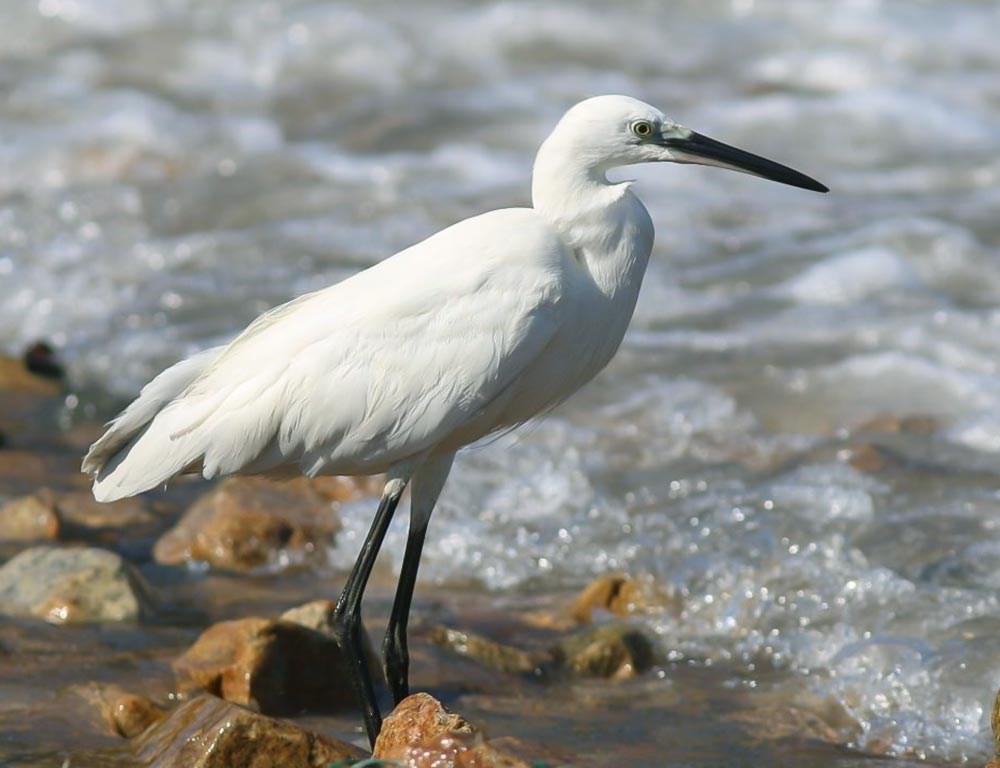
- Scientific name: Egretta eulophotes
- Life span: 20 years
- Size: 24 inches (60 cm)
- Weight: 1.1 lbs (0.5 kg)
- Wingspan: 39 inches (100 cm)
- Status: Vulnerable
The Chinese Egret is a graceful wader found in East Asia, particularly in China, Japan, and Korea.
With its striking white plumage and slender build, this egret primarily inhabits coastal habitats like mudflats and estuaries.
Its long, thin legs and slender, slightly upturned bill are adapted for hunting small fish, crustaceans, and insects in shallow waters.
2. Bald Eagle
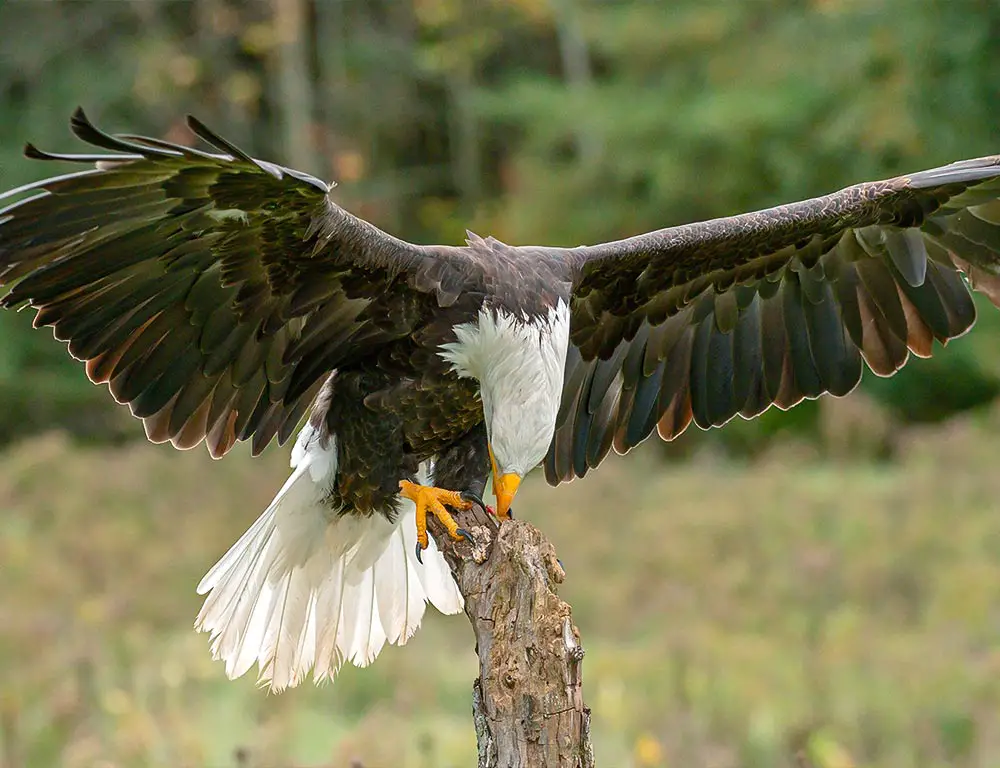
- Scientific name: Haliaeetus leucocephalus
- Life span: 20-30 years
- Size: 28-40 inches (71-101 cm)
- Weight: 6.6-13.2 lbs (3-6 kg)
- Wingspan: 6.1-7.5 feet (1.8-2.3 m)
- Status: Least Concern
The Bald Eagle, a symbol of the United States, is a majestic raptor found in North America. Recognizable by its distinctive white head and tail, it resides near large bodies of open water.
With powerful talons and a hooked beak, it preys on fish and waterfowl and occasionally scavenges carrion.
Bald Eagles are known for their impressive aerial displays during courtship.
3. Great Egret
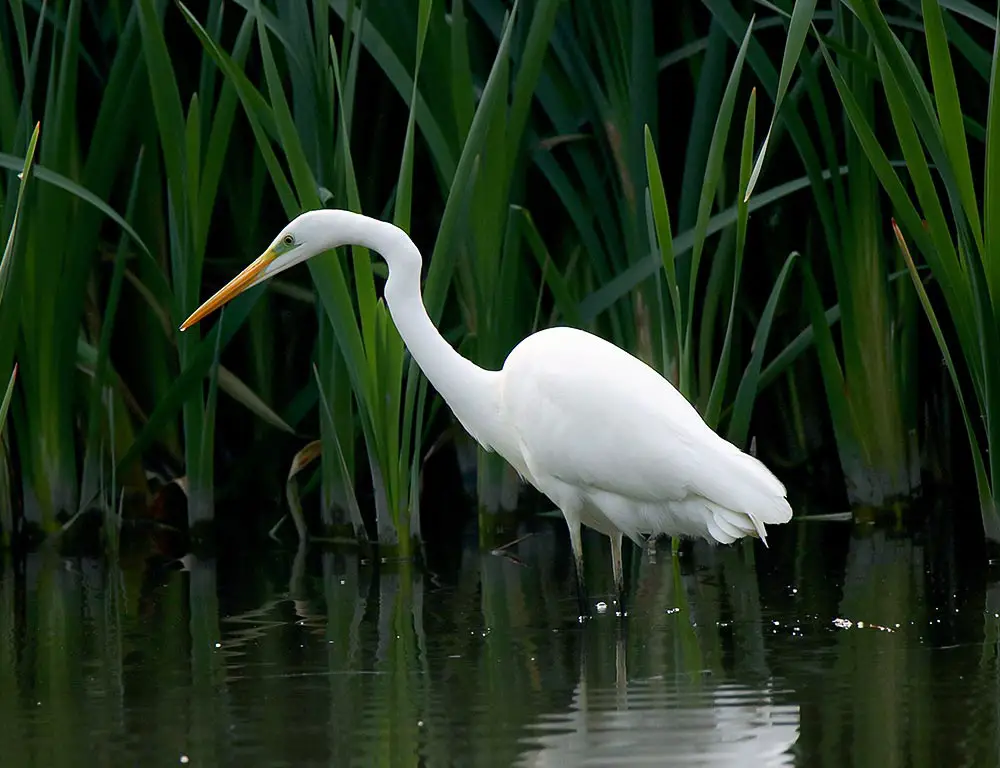
- Scientific name: Ardea alba
- Life span: 15 years
- Size: 37 inches (94 cm)
- Weight: 2.2 lbs (1 kg)
- Wingspan: 55 inches (140 cm)
- Status: Least Concern
The Great Egret is a cosmopolitan wader with white plumage and a distinctive S-shaped neck.
It inhabits various wetland habitats, including lakes, rivers, and marshes. With a slow and deliberate hunting style, it patiently stalks prey like fish, amphibians, and insects.
Its long, elegant plumes were once highly sought after for the feather trade, leading to conservation concerns.
4. Western Cattle Egret
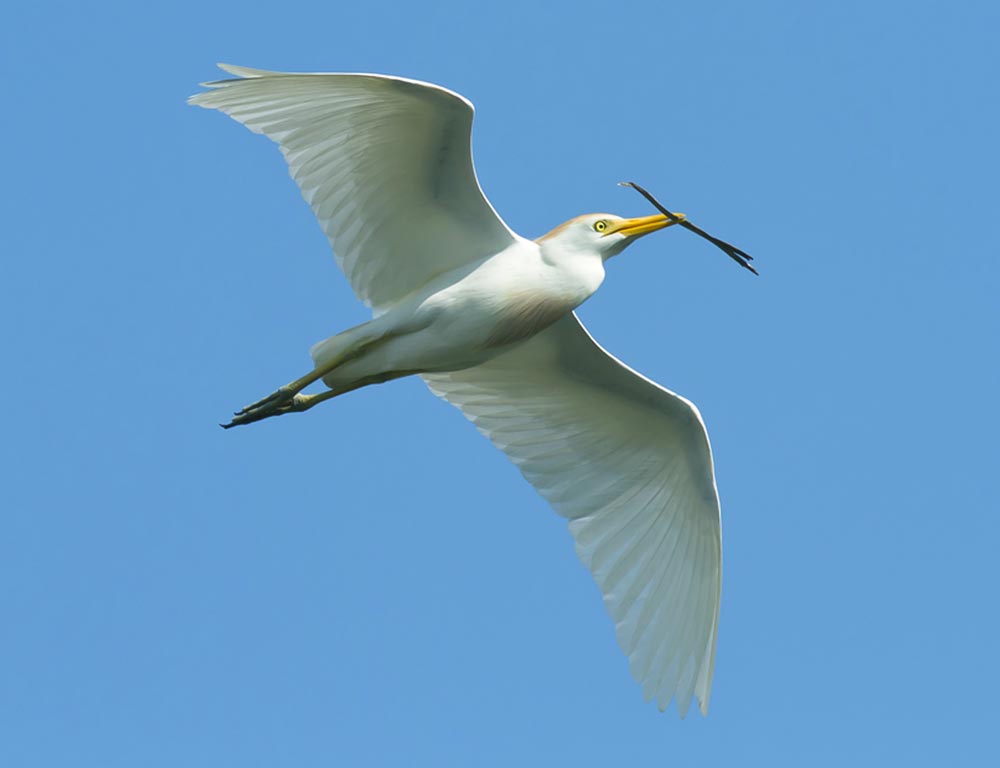
- Scientific name: Bubulcus ibis
- Life span: 10 years
- Size: 19 inches (48 cm)
- Weight: 0.9 lbs (0.4 kg)
- Wingspan: 35 inches (89 cm)
- Status: Least Concern
The Western Cattle Egret is a small heron known for associating with grazing livestock. Its white plumage, short stature, and yellow-orange bill distinguish it.
These birds forage near cattle, feeding on insects and small vertebrates disturbed by the movement of the livestock.
Their adaptability and willingness to exploit human-altered environments contribute to their widespread distribution.
5. Snowy Owl
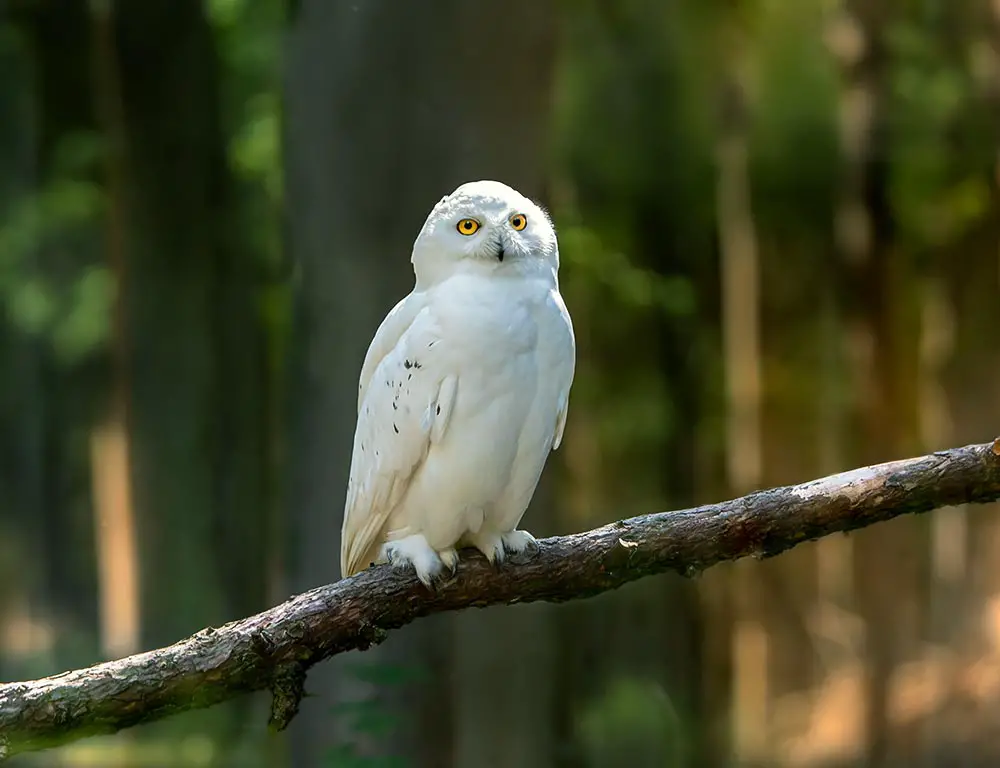
- Scientific name: Bubo scandiacus
- Life span: 9-10 years
- Size: 20-28 inches (50-71 cm)
- Weight: 3.5-6.6 lbs (1.6-3 kg)
- Wingspan: 49-59 inches (125-150 cm)
- Status: Least Concern
The Snowy Owl, known for its distinctive white plumage and large size, is a circumpolar bird found in the Arctic regions of North America and Eurasia.
These powerful predators mainly hunt lemmings and other small mammals. Their unique adaptation includes heavily feathered feet, providing insulation against the frigid Arctic temperatures.
Snowy Owls are known for occasional irruptions, migrating southward for food during periods of lemming population decline.
6. Snow Bunting
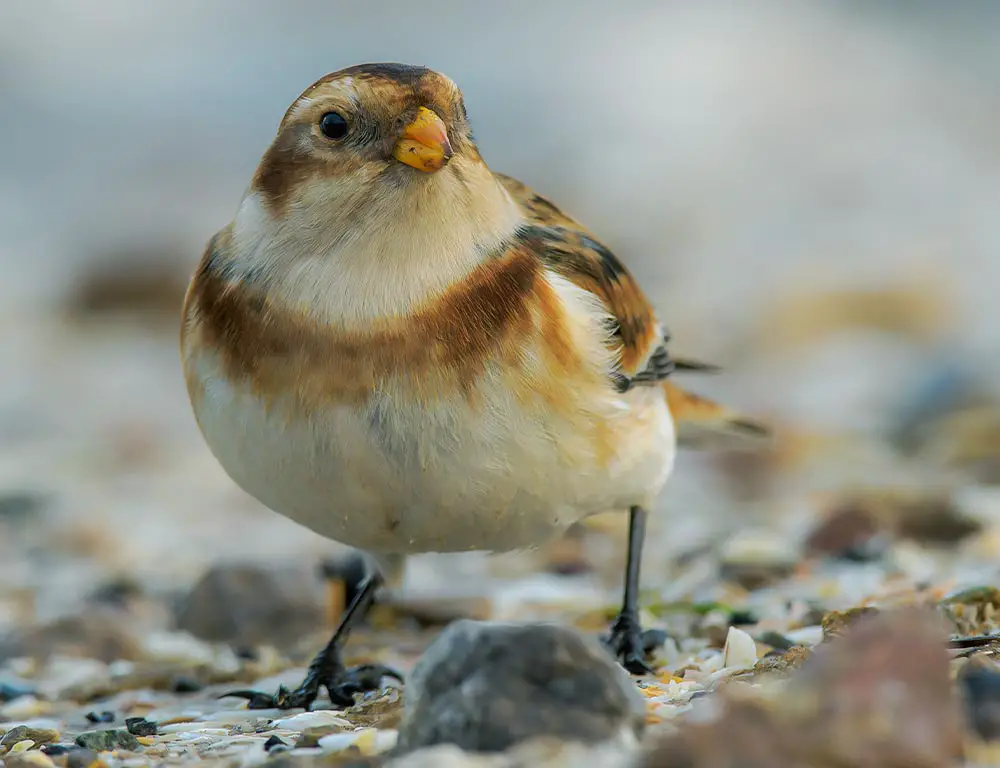
- Scientific name: Plectrophenax nivalis
- Life span: 4-6 years
- Size: 6.7-7.5 inches (17-19 cm)
- Weight: 1.1-1.7 oz (32-48 g)
- Wingspan: 11-13 inches (28-33 cm)
- Status: Least Concern
The Snow Bunting is a small, migratory songbird with white plumage and variable black markings, particularly during the breeding season.
These birds breed on rocky cliffs and tundra in Arctic and subarctic regions.
During winter, they migrate to more temperate regions, including parts of North America, Europe, and Asia. Snow Buntings primarily feed on seeds and insects, foraging on the ground and in low vegetation.
7. White Tern
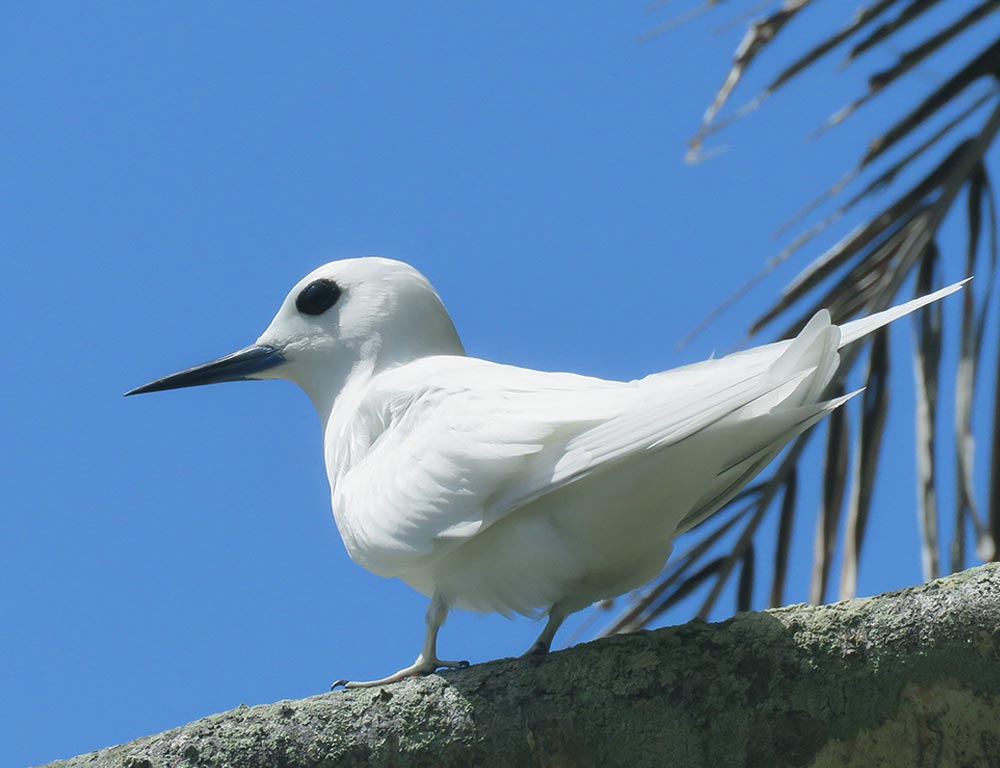
- Scientific name: Gygis alba
- Life span: Up to 20 years
- Size: 9 inches (23 cm)
- Weight: 1.9 oz (54 g)
- Wingspan: 15 inches (38 cm)
- Status: Least Concern
The White Tern, or the Fairy Tern, is a small seabird with an all-white plumage and distinctive black markings around the eyes.
It is found worldwide in tropical and subtropical regions, particularly in the Pacific and Indian Oceans.
White Terns are known for their unique nesting behavior, laying a single egg on thin branches or ledges without building a proper nest. They primarily feed on small fish and squid caught by aerial diving.
8. American White Pelican
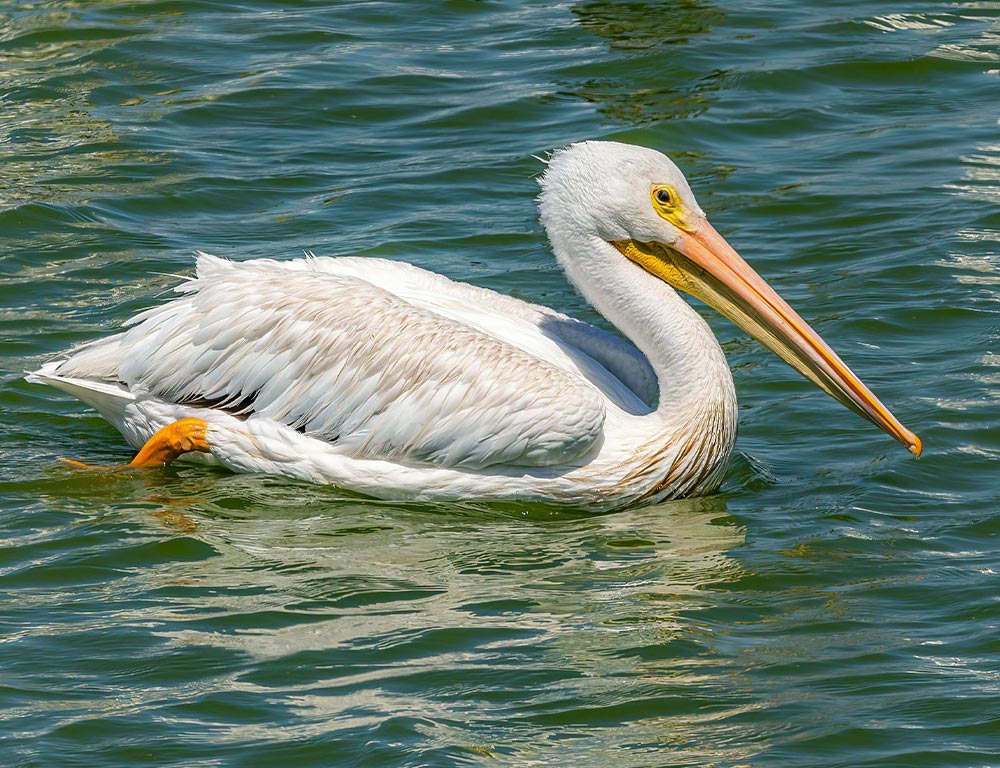
- Scientific name: Pelecanus erythrorrhynchos
- Life span: 10-25 years
- Size: 50-67 inches (127-170 cm)
- Weight: 11-20 lbs (5-9 kg)
- Wingspan: 95-120 inches (241-305 cm)
- Status: Least Concern
The American White Pelican is a large, long-winged bird with white plumage and a distinctive orange bill.
Found in North America, these pelicans prefer freshwater habitats, such as lakes and marshes. Unlike the brown pelican, they do not dive for fish.
Instead, they feed cooperatively by swimming in groups and herding fish into shallow water, where they scoop them up with their bills.
American White Pelicans are known for their impressive soaring flights and large breeding colonies.
9. Whooping Crane
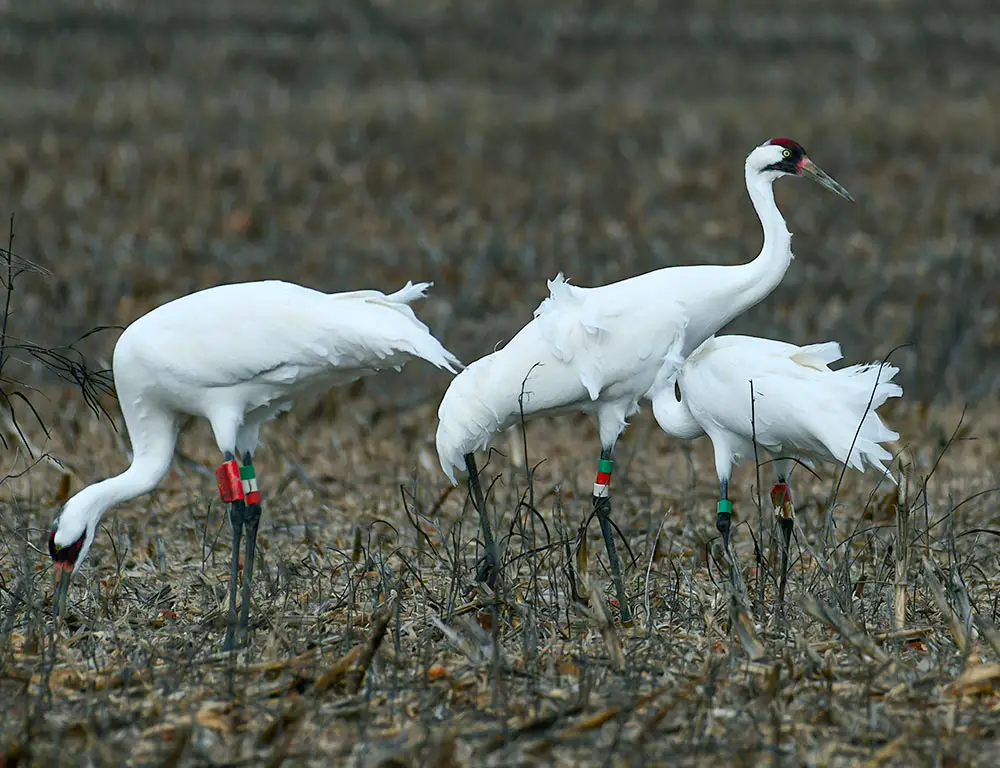
- Scientific name: Grus americana
- Life span: Up to 24 years
- Size: 52 inches (132 cm)
- Weight: 13-17 lbs (6-8 kg)
- Wingspan: 87 inches (221 cm)
- Status: Endangered
The Whooping Crane is one of North America’s rarest and tallest bird species, characterized by its distinctive white plumage with black wingtips and a red crown.
This crane migrates between breeding grounds in Canada and wintering areas along the Gulf of Mexico.
Conservation efforts, including captive breeding and reintroduction programs, aim to recover this critically endangered species.
They feed on various aquatic invertebrates, small vertebrates, and plants in both wetland and upland habitats.
10. Snowy Egret
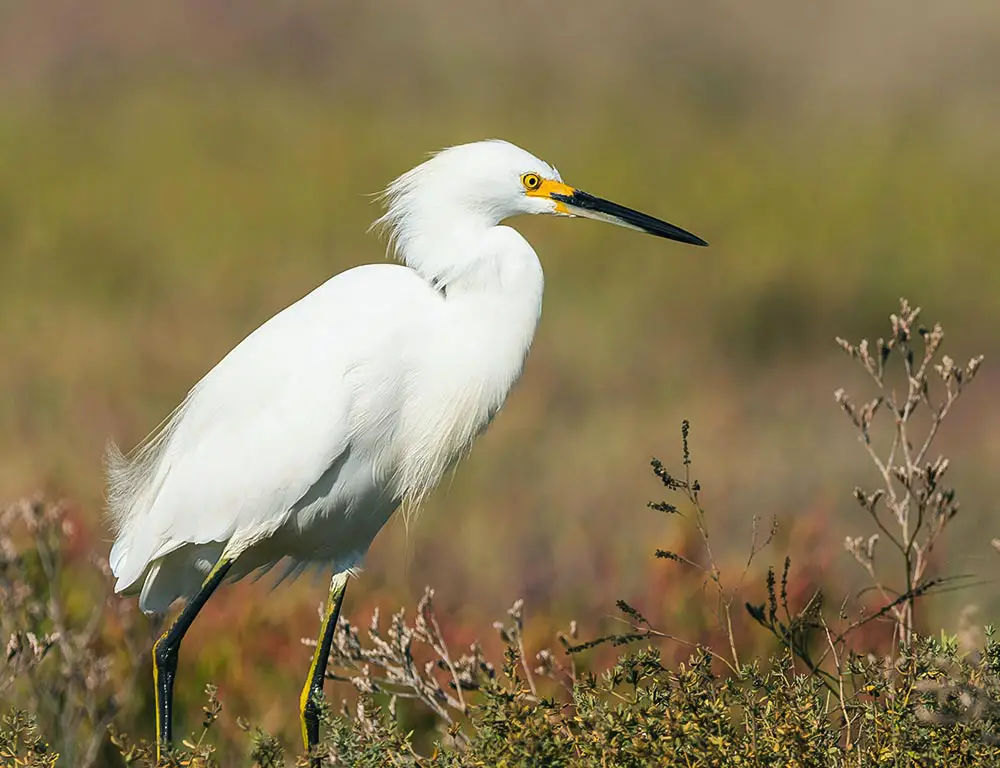
- Scientific name: Egretta thula
- Life span: 6-10 years
- Size: 22 inches (56 cm)
- Weight: 13-17 oz (370-480 g)
- Wingspan: 39 inches (99 cm)
- Status: Least Concern
The Snowy Egret is a small, elegant wader with striking white plumage, a slender black bill, and distinctive yellow feet.
Found in North and South America, these egrets inhabit various wetland habitats, such as marshes, ponds, and estuaries.
Known for their active hunting behavior, they wade through shallow waters, using their bright yellow feet to stir up prey. Their diet includes fish, amphibians, crustaceans, and insects.
11. American Kestrel
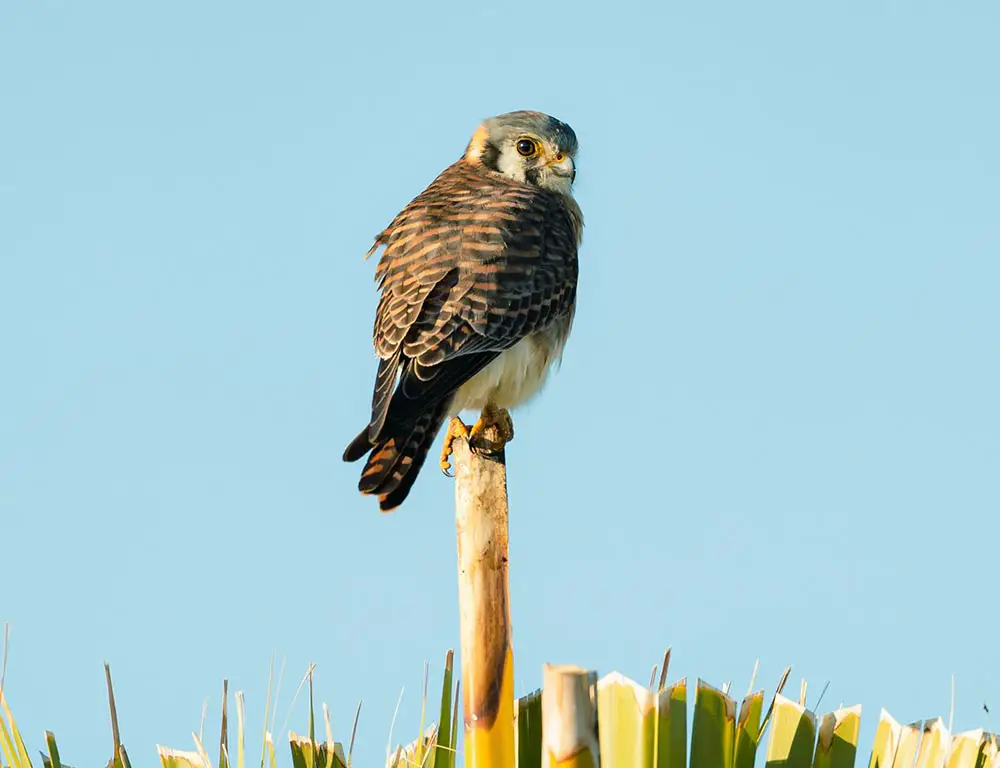
- Scientific name: Falco sparverius
- Life span: 5-10 years
- Size: 8-12 inches (20-30 cm)
- Weight: 2.8-5.8 oz (80-165 g)
- Wingspan: 20-24 inches (51-61 cm)
- Status: Least Concern
The American Kestrel is a small, colorful falcon with a distinctive combination of rufous and blue-gray plumage.
Found throughout North and South America, these kestrels occupy diverse habitats, including grasslands, deserts, and urban areas.
They are known for their hovering hunting technique, preying on insects, small mammals, and birds. American Kestrels are cavity nesters, often utilizing old woodpecker holes or artificial nest boxes.
12. Merlin
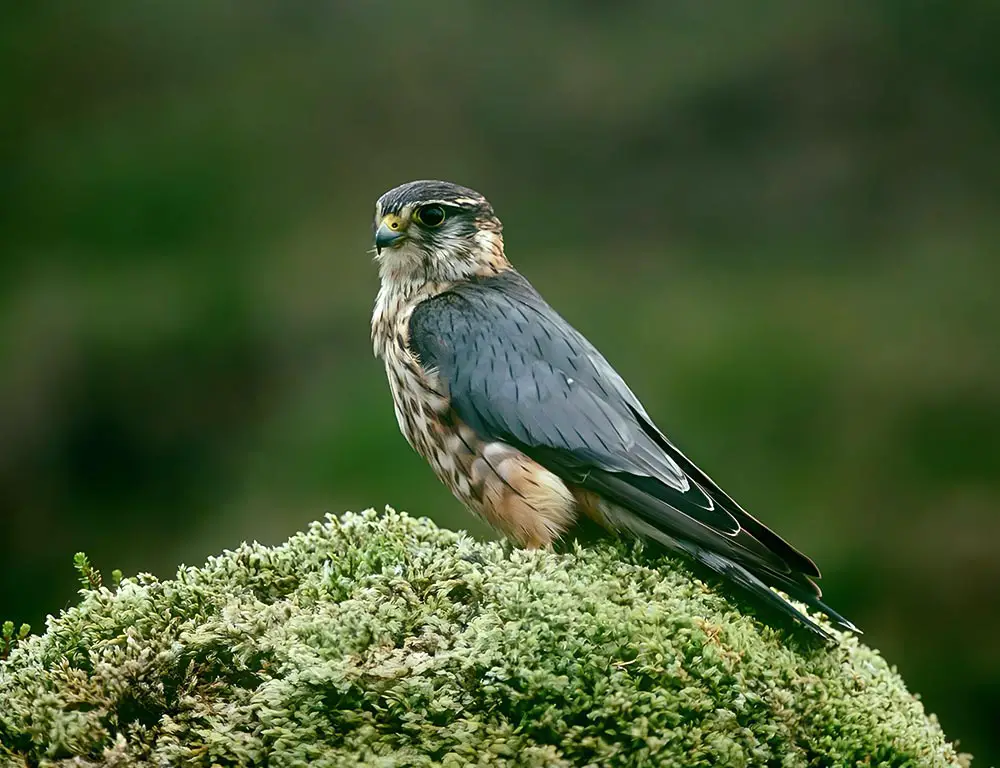
- Scientific name: Falco columbarius
- Life span: 4-8 years
- Size: 9-13 inches (23-33 cm)
- Weight: 6.5-13 oz (180-370 g)
- Wingspan: 20-26 inches (51-66 cm)
- Status: Least Concern
The Merlin is a small, swift falcon with a versatile range, found in various habitats from tundra to urban areas.
They are agile hunters with blue-gray backs and orange-tinged underparts, preying on small birds, insects, and occasionally bats.
Merlin Falcons exhibit a rapid, direct flight style and are known for catching prey on the wing.
During the breeding season, they construct nests on cliffs, in trees, or even on the ground in some cases.
13. Kelp Gull
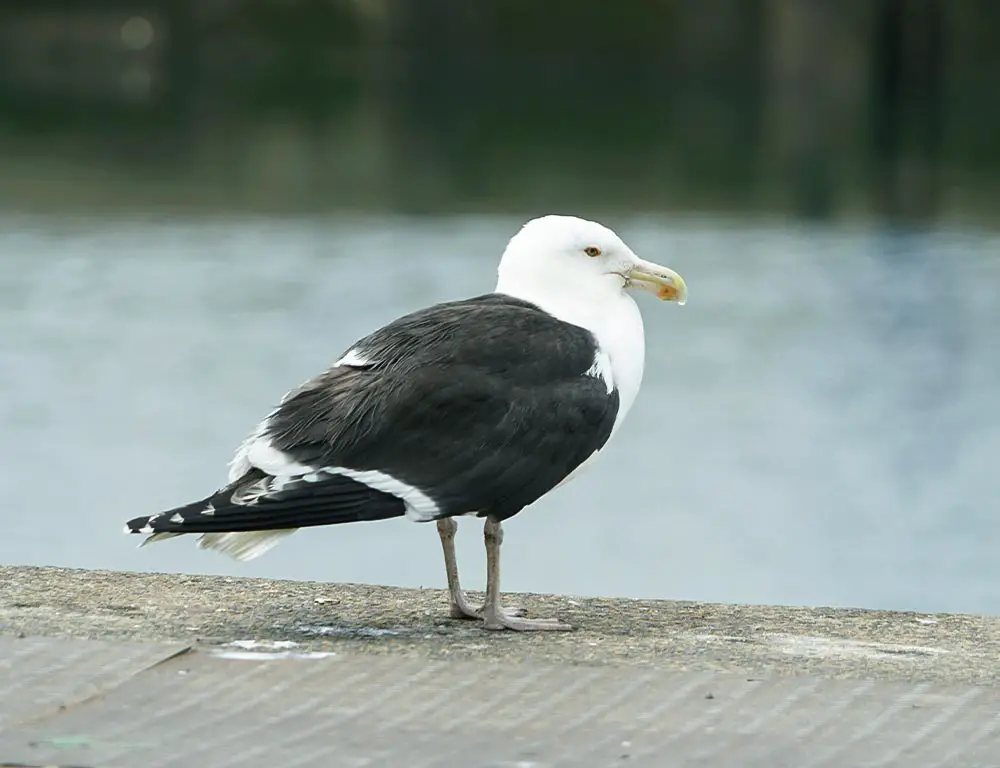
- Scientific name: Larus dominicanus
- Life span: 20-30 years
- Size: 20-24 inches (50-61 cm)
- Weight: 1.5-2.2 lbs (0.7-1 kg)
- Wingspan: 51-56 inches (130-142 cm)
- Status: Least Concern
The Kelp Gull is a large, robust gull with dark plumage, a white head, and a distinctive yellow bill.
Found along coastal areas in the Southern Hemisphere, including South America, Africa, Australia, and New Zealand, they are opportunistic scavengers and skilled hunters.
Their diet includes fish, invertebrates, carrion, and even stealing food from other birds. Kelp Gulls are highly adaptable and can be observed in various coastal environments, from beaches to landfills.
14. Peregrine Falcon
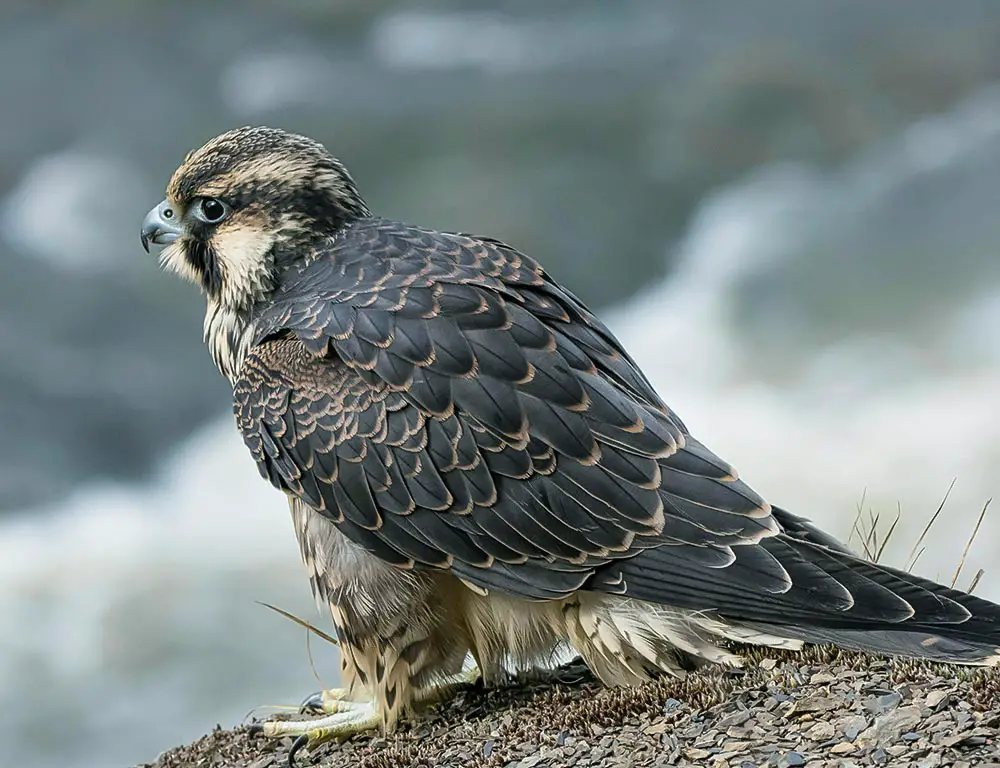
- Scientific name: Falco peregrinus
- Life span: 8-15 years
- Size: 14-20 inches (36-51 cm)
- Weight: 1.2-3.3 lbs (0.5-1.5 kg)
- Wingspan: 29-47 inches (74-120 cm)
- Status: Least Concern
The Peregrine Falcon is a powerful raptor known for its incredible speed and aerial hunting prowess.
With a blue-gray back and white underparts, it has a distinctive black facial “mustache.” Peregrines are found worldwide, nesting on cliffs and tall structures like skyscrapers.
Their diet consists mainly of birds, and they are renowned for their high-speed stoop (dive) during hunting. Peregrine Falcons were once endangered due to pesticide exposure but have remarkably recovered thanks to conservation efforts.
15. Ivory Gull
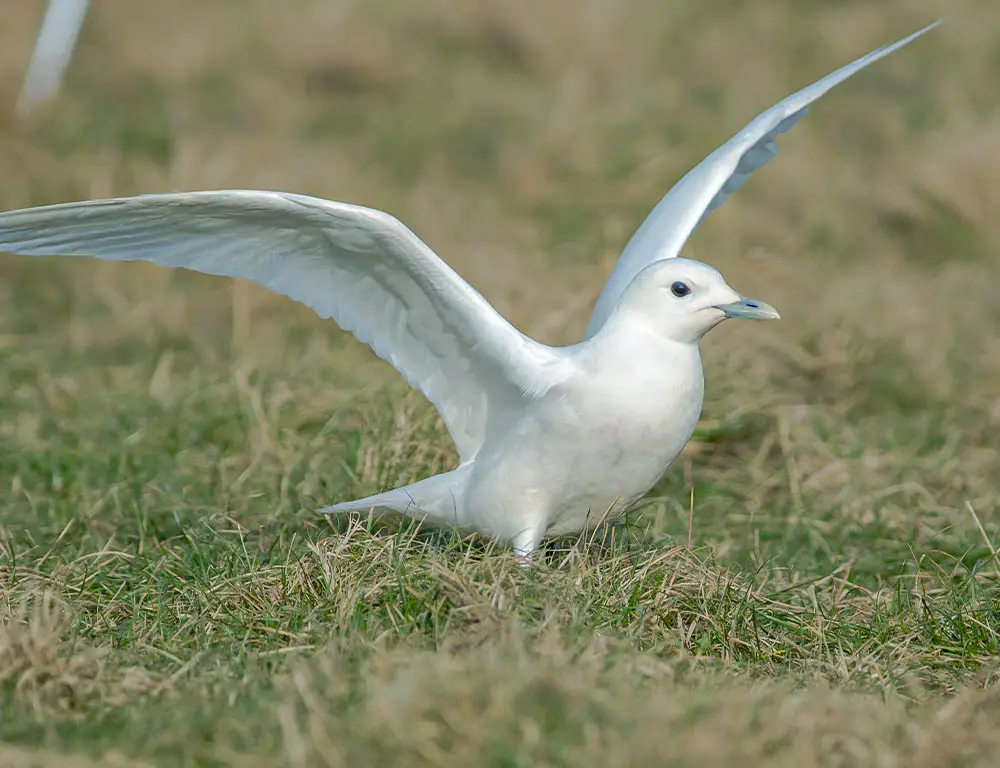
- Scientific name: Pagophila eburnea
- Life span: Up to 10 years
- Size: 16-20 inches (41-51 cm)
- Weight: 0.9-1.3 lbs (400-600 g)
- Wingspan: 41-45 inches (104-115 cm)
- Status: Vulnerable
The Ivory Gull is a distinctive, all-white seabird with black legs and a short, stubby bill.
Found in the Arctic regions, including the high Arctic and subarctic zones, they are well-adapted to icy environments. Ivory Gulls primarily feed on fish and invertebrates, and they are known for scavenging carrion, including polar bear kills.
Their population is vulnerable due to climate change impacting their Arctic breeding grounds.
16. Eastern Screech-Owl
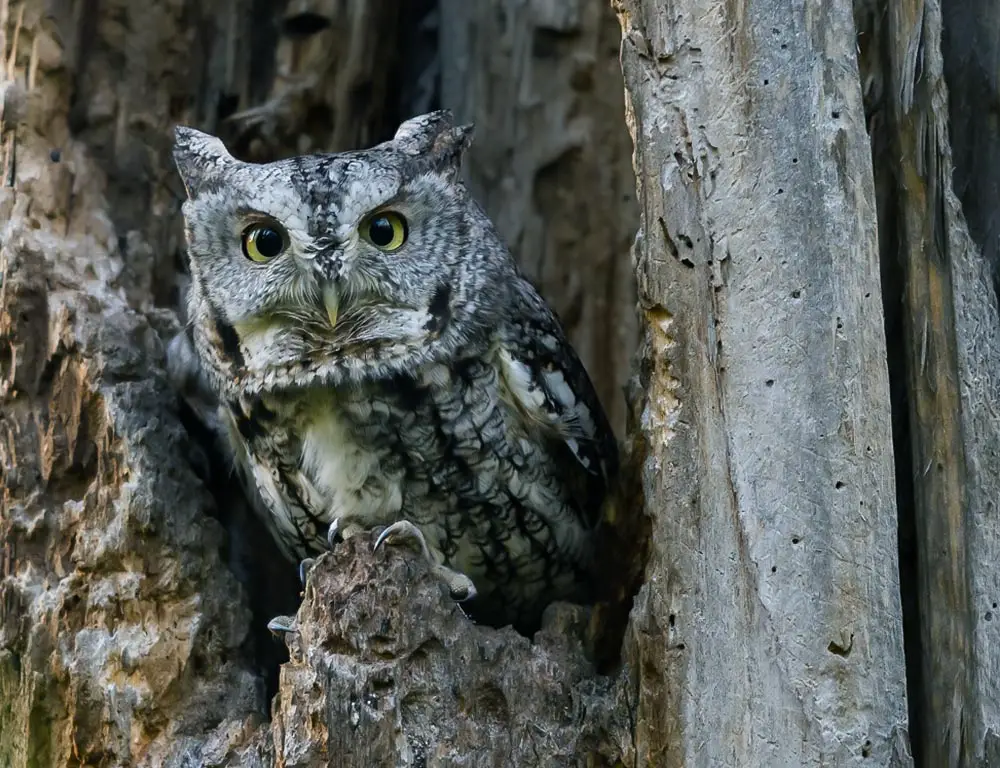
- Scientific name: Megascops asio
- Life span: 6-8 years
- Size: 6-10 inches (15-25 cm)
- Weight: 4-8 oz (110-230 g)
- Wingspan: 18-24 inches (46-61 cm)
- Status: Least Concern
The Eastern Screech-Owl is a small, nocturnal owl with excellent camouflage found in eastern North America.
Their plumage can be gray or reddish-brown to blend with their surroundings. These owls are adaptable and can inhabit various habitats, including woodlands, parks, and suburban areas.
They feed on small mammals, birds, and insects. Eastern screech owls are known for their distinctive trilling or whinnying calls during the breeding season.
17. Great Horned Owl
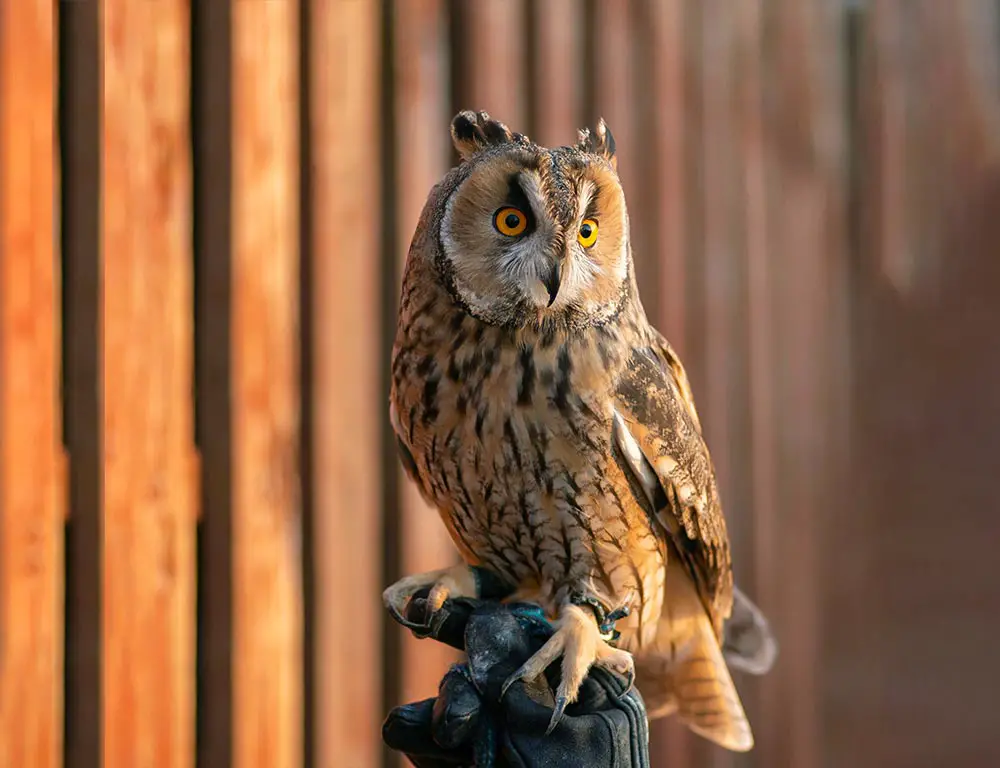
- Scientific name: Bubo virginianus
- Life span: 5-15 years
- Size: 18-25 inches (46-64 cm)
- Weight: 2-5.5 lbs (0.9-2.5 kg)
- Wingspan: 3.3-4.8 feet (1-1.5 meters)
- Status: Least Concern
The Great Horned Owl is a large, powerful owl with distinctive ear tufts and a mottled brownish appearance. Widely distributed throughout the Americas, it adapts to various habitats, including forests, deserts, and urban areas.
Known for its hooting calls, the Great Horned Owl is a formidable predator, preying on mammals, birds, and even other raptors. It is one of the most widespread and adaptable owls in North America.
18. Snowy Owl
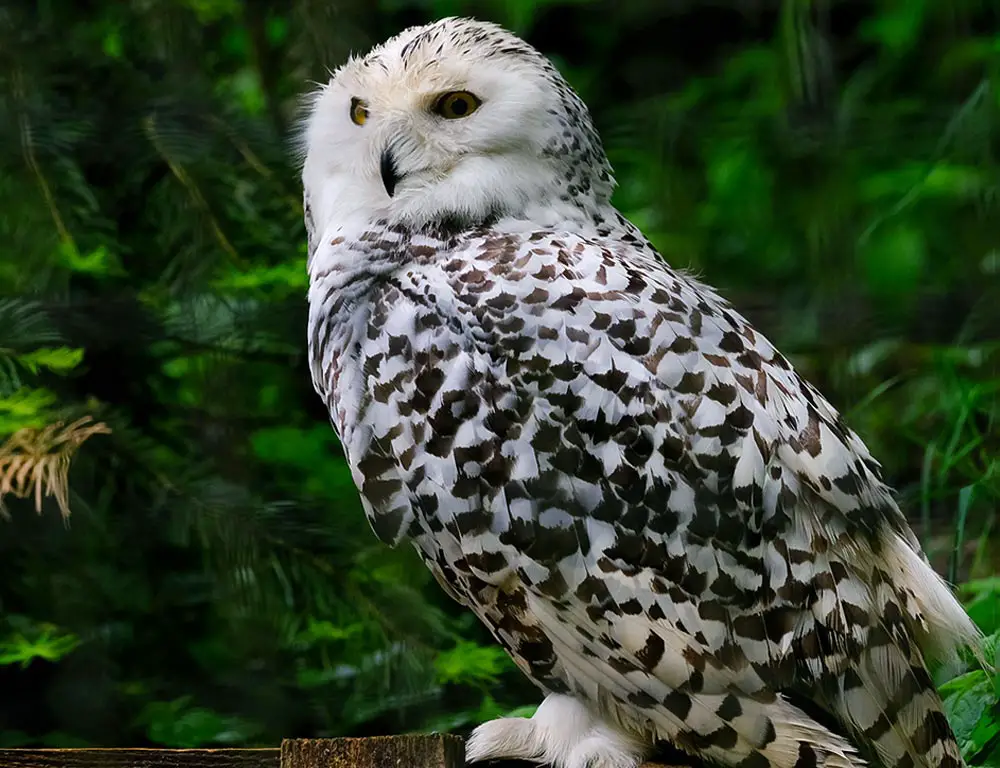
- Scientific name: Bubo scandiacus
- Life span: 9-10 years
- Size: 20-28 inches (50-71 cm)
- Weight: 3.5-6.6 lbs (1.6-3 kg)
- Wingspan: 49-59 inches (125-150 cm)
- Status: Least Concern
The Snowy Owl, an iconic bird of the Arctic, is recognized by its striking all-white plumage, large size, and yellow eyes.
While primarily found in the Arctic tundra, Snowy Owls can migrate south in winter, occasionally reaching regions far beyond their typical range.
They are opportunistic hunters, specializing in lemmings when available, and are known for their ability to withstand harsh, snowy environments.
19. Belcher’s Gull
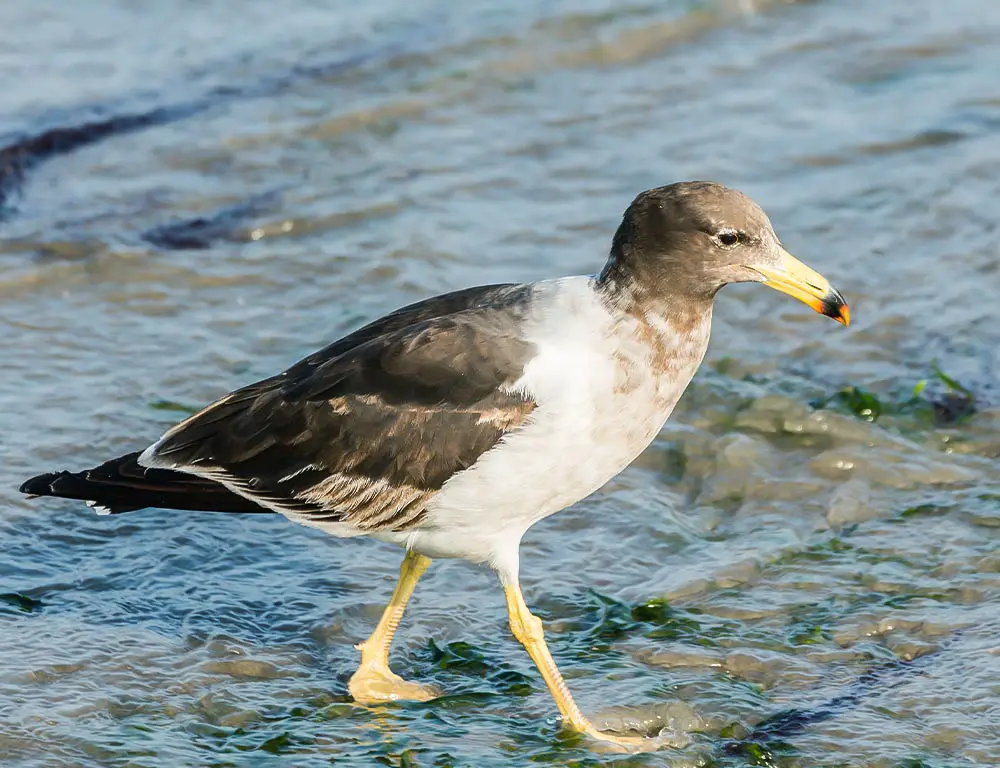
- Scientific name: Larus belcheri
- Life span: 18 years
- Size: 20-22 inches (50-56 cm)
- Weight: 0.9-1.2 lbs (400-550 g)
- Wingspan: 53 inches (135 cm)
- Status: Least Concern
Belcher’s Gull is a medium-sized gull with a distinctive black hood and white body. Found along the west coast of South America, from southern Peru to southern Chile, it nests on rocky cliffs and forages in coastal areas.
These gulls are opportunistic feeders, consuming fish and invertebrates and scavenging on carrion. Their populations face threats from habitat disturbance and pollution in some regions.
20. Pacific Gull
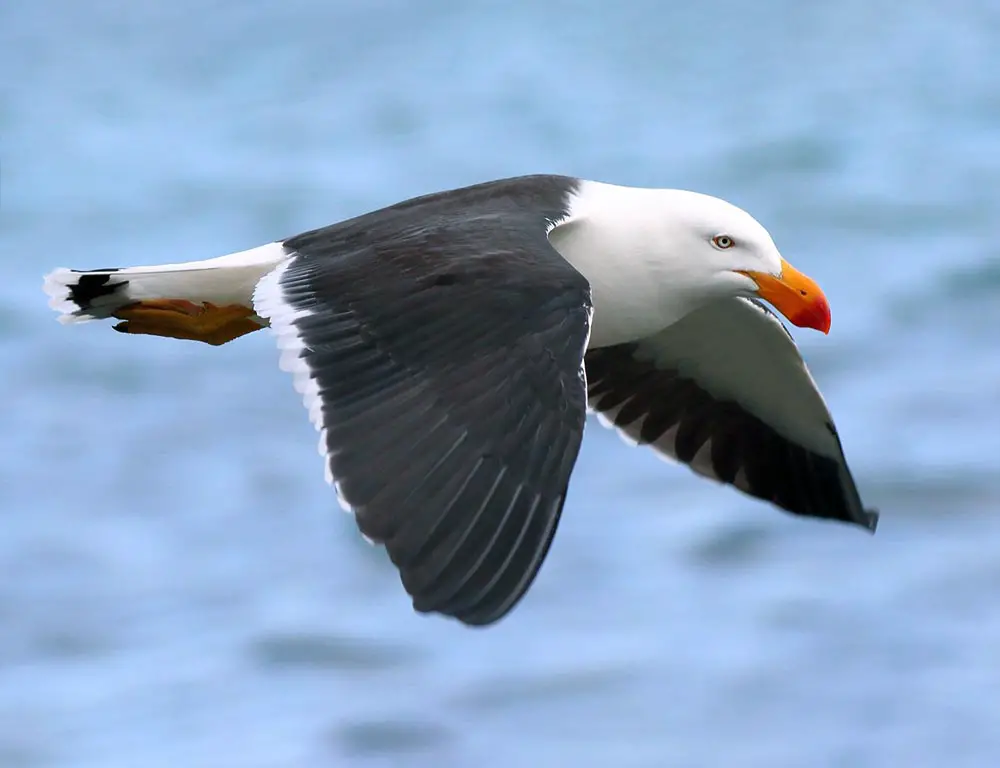
- Scientific name: Larus pacificus
- Life span: 20 years
- Size: 24-30 inches (61-76 cm)
- Weight: 2.6-4.4 lbs (1.2-2 kg)
- Wingspan: 54-60 inches (137-152 cm)
- Status: Least Concern
The Pacific Gull is a large, robust gull native to Australia. With a white head, dark mantle, and yellow bill, it’s often found along the coastline, foraging on beaches and estuaries, and scavenging at human settlements.
These gulls are known for their powerful flight and opportunistic feeding habits, consuming various marine life, small vertebrates, and even garbage.
21. Short-eared Owl
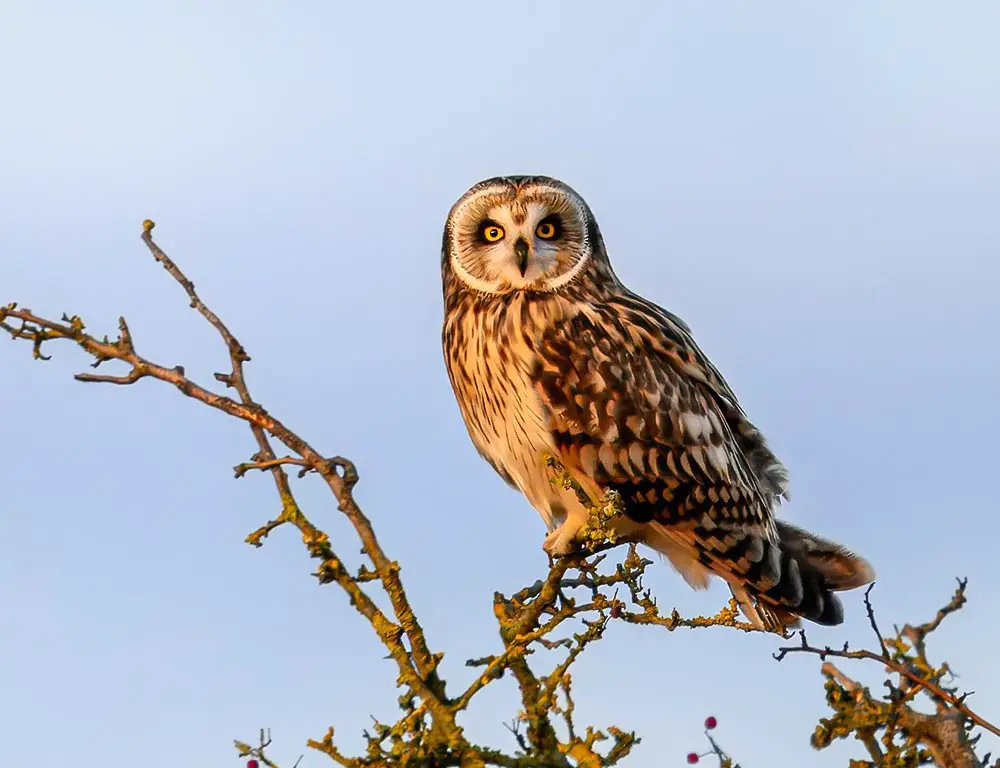
- Scientific name: Asio flammeus
- Life span: 3-5 years
- Size: 13-17 inches (33-43 cm)
- Weight: 7-17 oz (200-480 g)
- Wingspan: 33-43 inches (84-110 cm)
- Status: Least Concern
The Short-eared Owl is a medium-sized owl with distinctive facial disks and short, feathered “ears.” Widely distributed across the globe, these owls inhabit open grasslands, marshes, and tundra.
Unlike many owls, Short-eared Owls are diurnal and can often be seen hunting during daylight hours.
Their diet consists mainly of small mammals and birds, and they are known for their hovering and quartering flight patterns over open landscapes.
22. Snow Bunting
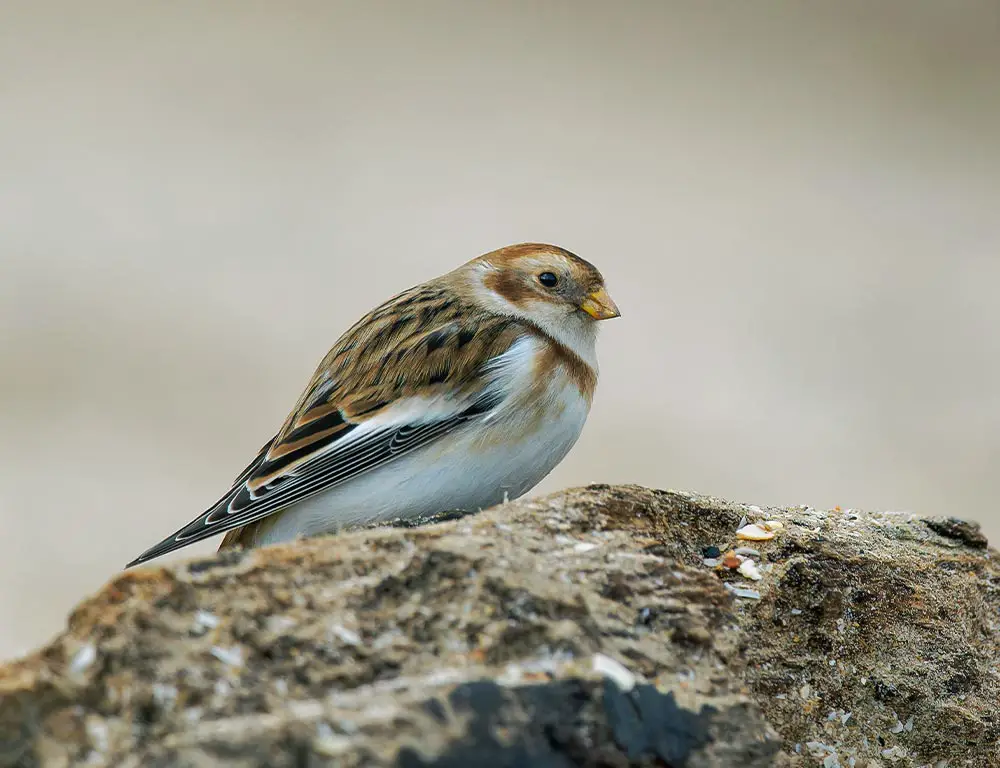
- Scientific name: Plectrophenax nivalis
- Life span: 4-6 years
- Size: 6.7-7.5 inches (17-19 cm)
- Weight: 1.1-1.7 oz (32-48 g)
- Wingspan: 11-13 inches (28-33 cm)
- Status: Least Concern
The Snow Bunting is a small, Arctic-breeding passerine known for its striking winter plumage. During the breeding season, males display a mix of black and white, while the non-breeding females are mostly brown.
They inhabit tundra and rocky areas and, during winter, migrate to more temperate regions. Snow Buntings primarily feed on seeds, grasses, and insects, and they are often seen foraging on the ground in flocks.
23. California Gull
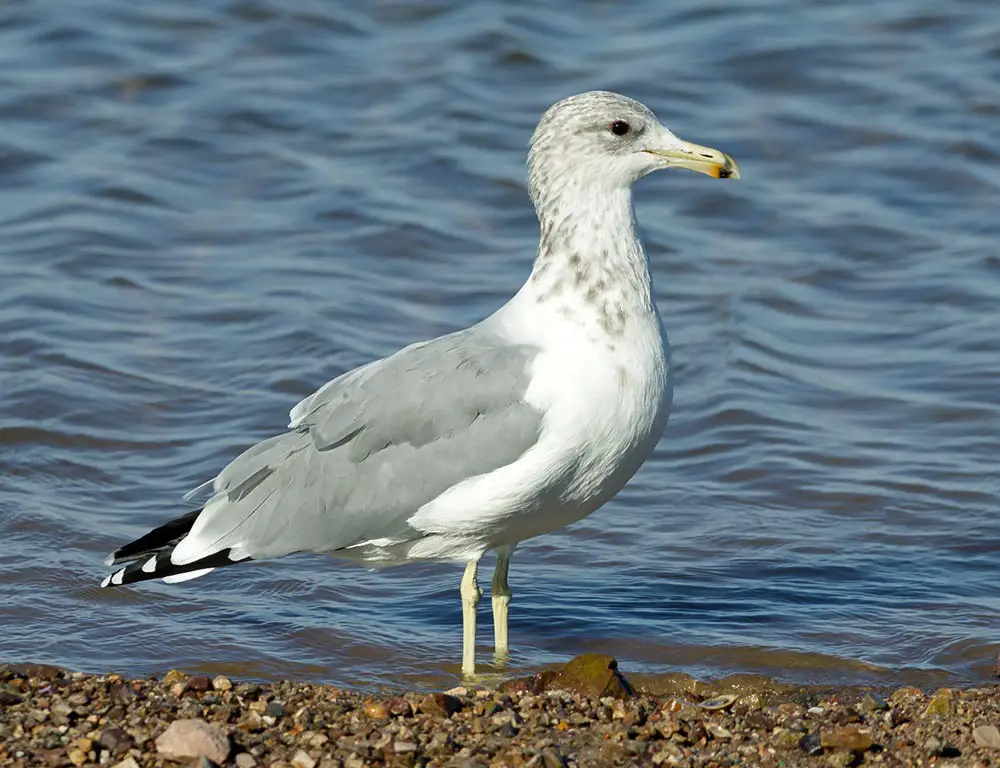
- Scientific name: Larus californicus
- Life span: Up to 15 years
- Size: 18-22 inches (46-56 cm)
- Weight: 1.2-2.1 lbs (550-950 g)
- Wingspan: 51-57 inches (130-145 cm)
- Status: Least Concern
The California Gull is a medium to large-sized gull native to the western part of North America. With a white head, gray wings, and yellow bill, these gulls are often found in coastal areas, lakes, and rivers.
They are opportunistic feeders, consuming a varied diet, including fish, insects, and scavenging for human food. California Gulls are known for their distinctive calls and play a role in the folklore of the American West.
24. White-headed House Finch
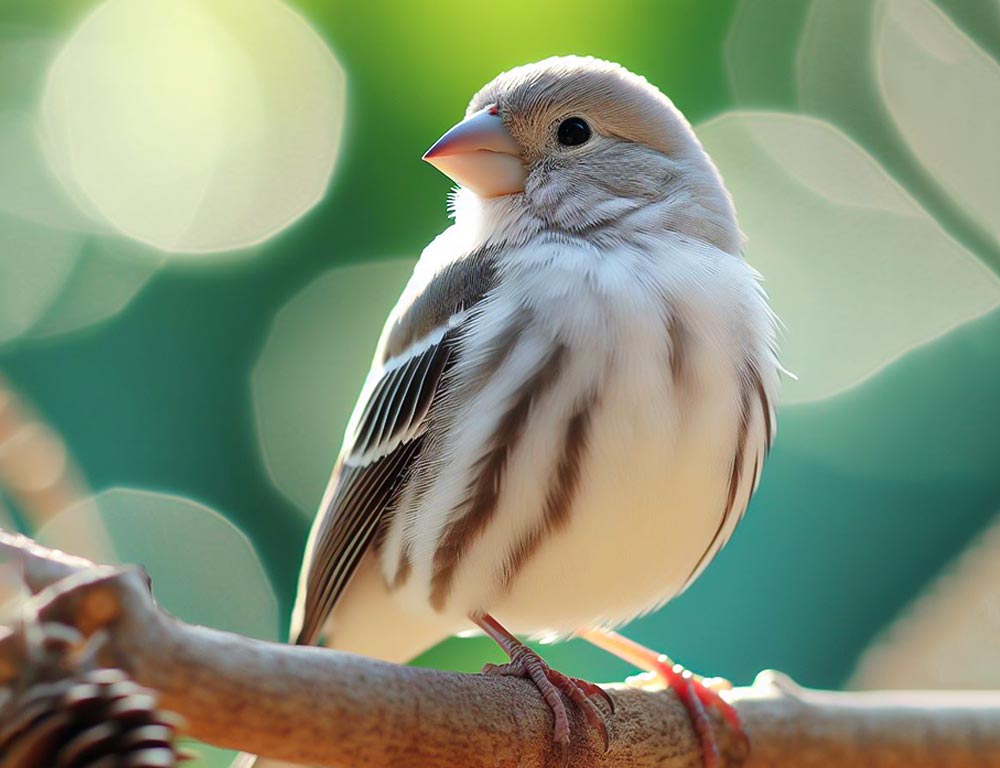
- Scientific name: Haemorhous mexicanus
- Life span: 5-7 years
- Size: 5-6 inches (13-15 cm)
- Weight: 0.6-1 oz (17-28 g)
- Wingspan: 7-9 inches (18-23 cm)
- Status: Least Concern
While the House Finch typically exhibits red plumage on the head and throat, there are rare instances where a genetic mutation causes a white-headed variation.
House Finches are common in urban and suburban areas across North America.
They are granivores, feeding on seeds and grains, and are often found at bird feeders. The white-headed variation is an example of natural color variation within the species.
25. Black-Browed Albatross
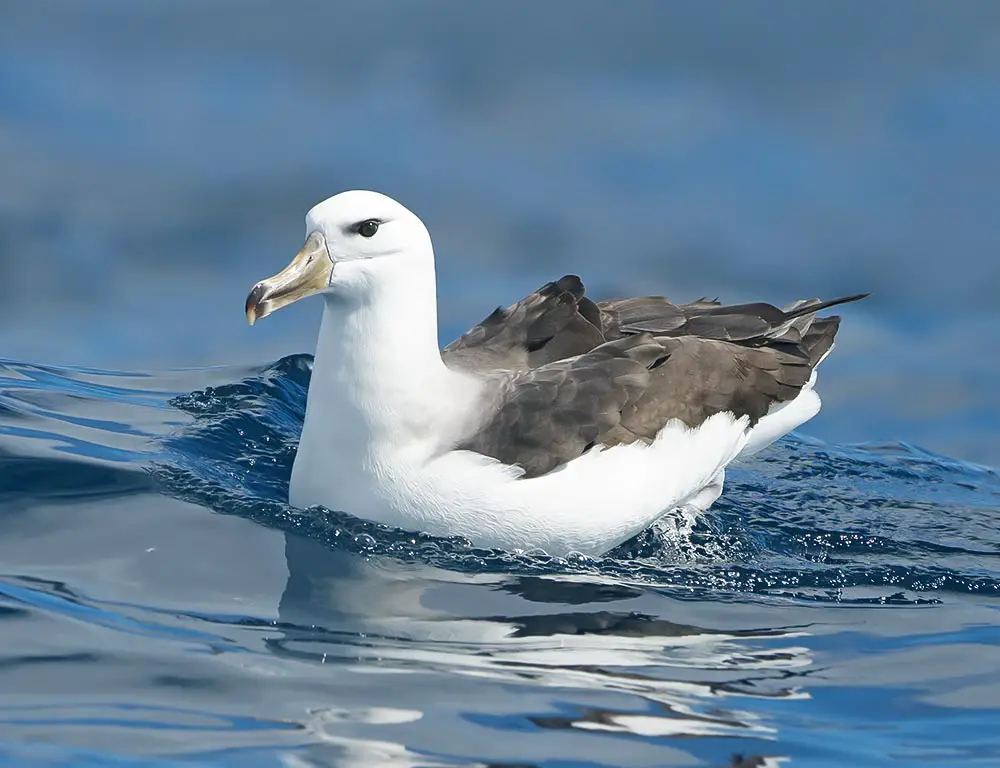
- Scientific name: Thalassarche melanophris
- Life span: Up to 70 years
- Size: 31-36 inches (80-91 cm)
- Weight: 5-9 lbs (2.3-4 kg)
- Wingspan: 7-8 feet (2.1-2.4 meters)
- Status: Near Threatened
The Black-Browed Albatross is a large seabird known for its distinctive black eyebrow markings.
Found in the Southern Ocean, particularly around sub-Antarctic islands, these albatrosses have a circumpolar distribution.
They are long-distance travelers, covering vast distances over the open ocean.
Black-Browed Albatrosses primarily feed on fish, squid, and crustaceans, and they are vulnerable to threats such as longline fishing and climate change.
26. White-Headed Woodpecker
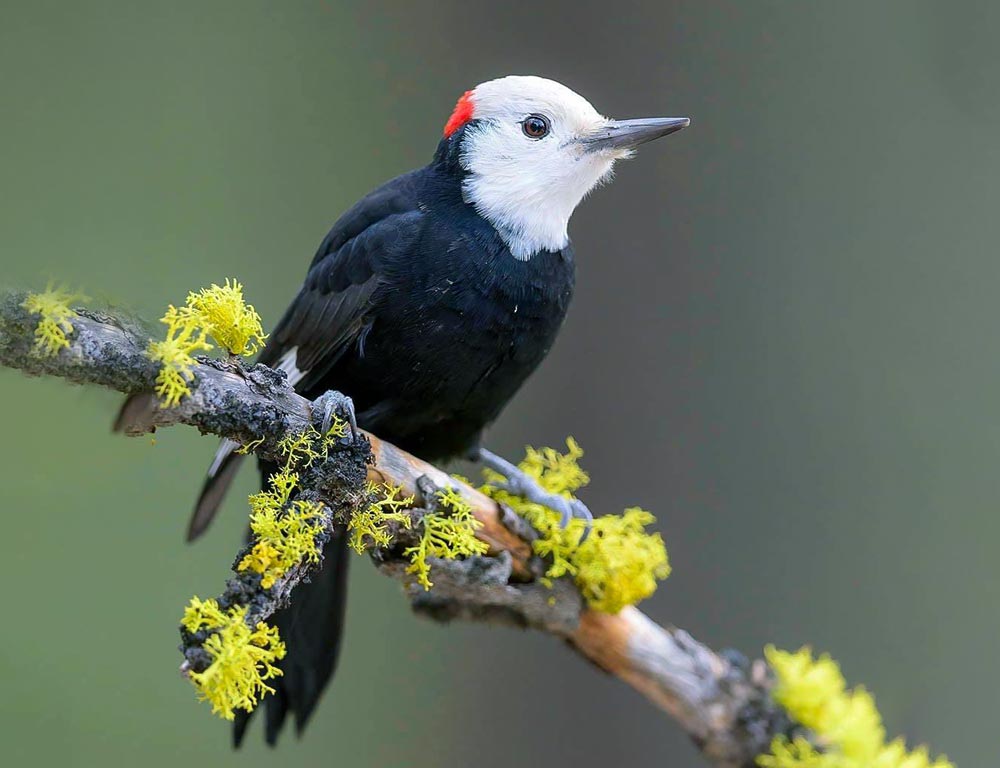
- Scientific name: Picoides albolarvatus
- Life span: Up to 9 years
- Size: 8-10 inches (20-25 cm)
- Weight: 2-3 oz (57-85 g)
- Wingspan: 16-18 inches (41-46 cm)
- Status: Least Concern
The White-Headed Woodpecker is a striking woodpecker species found in coniferous forests in western North America. As the name suggests, it has a distinctive white head, black body, and white wing patches.
These woodpeckers feed on insects, particularly wood-boring beetles, by excavating tree cavities.
They are associated with mature pine forests and are adapted to a diet that includes pine seeds during certain times of the year. Conservation efforts are in place to manage and protect their habitat.
Wrapping Up
Birds with white heads exemplify the intricate tapestry of biodiversity. From the Snowy Owl to the coastal havens frequented by the California Gull, these avian wonders showcase nature’s adaptability and resilience.
Their ecological roles, behaviors, and conservation statuses underscore the interconnectedness of all living beings.
As we delve into their worlds, it becomes evident that safeguarding these birds and their habitats is a matter of avian preservation and a commitment to maintaining the delicate balance of our planet’s diverse ecosystems. Thank you very much.